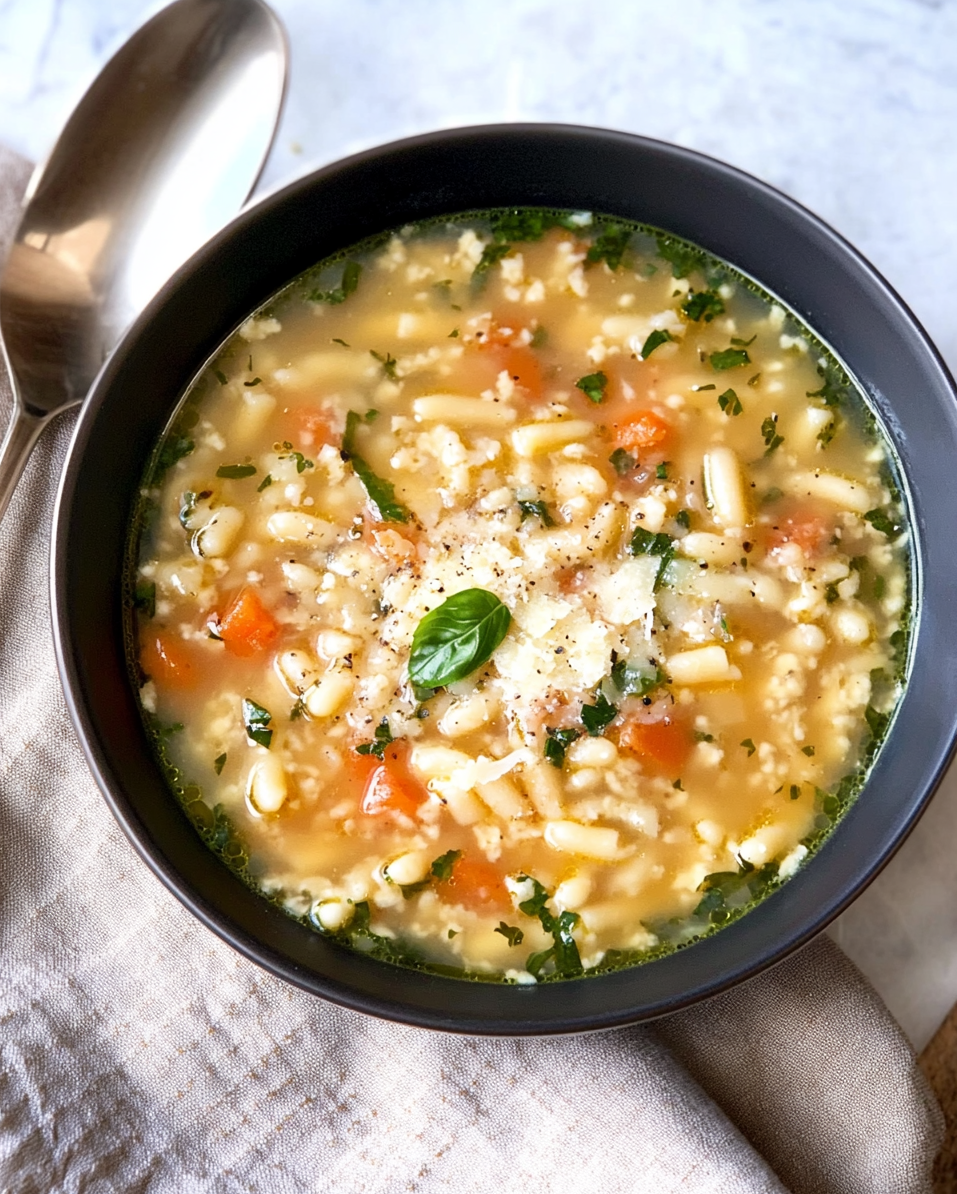This Classic Italian Pastina Soup is the ultimate comfort dish, bringing warmth and simplicity to your table. The tiny pastina pasta, cooked to perfection in savory chicken broth, is complemented by delicate egg ribbons and a sprinkle of Parmesan, creating a nourishing bowl of goodness.
Ideal for a quick weeknight meal or a soothing lunch, this soup is easy to prepare and even easier to enjoy. With its rich, comforting flavors and delightful textures, it’s sure to become a staple in your recipe collection. Pair it with a slice of crusty bread for an even more satisfying experience.
Full Recipe:
- 1/2 cup pastina pasta
- 4 cups chicken broth
- 1 egg, beaten
- 1 tablespoon grated Parmesan cheese
- Salt and pepper to taste
- Fresh parsley, chopped (optional)
Directions:
- Bring the chicken broth to a boil in a medium-sized pot.
- Add the pastina pasta to the boiling broth and cook according to the package instructions, typically about 4-5 minutes.
- Once the pasta is cooked, lower the heat to a gentle simmer.
- Slowly pour in the beaten egg while stirring the soup continuously to create egg ribbons.
- Stir in the grated Parmesan cheese until fully incorporated.
- Season with salt and pepper to taste.
- Garnish with chopped fresh parsley if desired and serve hot.
Prep Time: 5 minutes | Cooking Time: 10 minutes | Total Time: 15 minutes
Kcal: 120 kcal | Servings: 2 servings
A Closer Look at Classic Italian Pastina Soup
Pastina is the Italian word for “little pasta,” and it comes in various shapes, but it’s most commonly associated with tiny, star-shaped pasta. This dish is a staple in Italian households, often referred to as a “comfort food” for good reason. Its simplicity and heartwarming qualities make it a go-to recipe for anyone in need of a quick and satisfying meal.
The History of Pastina Soup
Pastina soup has deep roots in Italian cuisine, often served to children, the elderly, or anyone recovering from an illness due to its mild, easily digestible nature. It’s a dish that many Italians associate with their childhood, often made by mothers and grandmothers as a nourishing meal during cold days. The combination of a rich broth, tender pasta, and the creamy addition of an egg makes it both nutritious and soothing.
Nutritional Benefits
This dish is not only comforting but also offers several nutritional benefits:
- Chicken Broth: Provides a good source of protein and is known for its healing properties, especially when made from scratch. It’s rich in collagen, which supports joint health, and amino acids like cysteine, which may help thin mucus in the lungs, making it easier to breathe when you have a cold.
- Egg: Adds a good dose of protein and healthy fats, making the soup more filling. It also introduces essential vitamins such as B12 and D.
- Parmesan Cheese: While used sparingly, Parmesan cheese contributes a rich umami flavor, along with calcium and phosphorus, which are essential for bone health.
- Pastina: As a form of pasta, pastina is a source of carbohydrates, which provide the body with energy. It’s light on the stomach, making it a good choice for those who need something easy to digest.
Variations to Try
While the classic recipe is beloved for its simplicity, there are several variations you can experiment with:
- Vegetarian Version: Substitute chicken broth with vegetable broth for a vegetarian-friendly option. You can also add finely chopped vegetables like carrots, celery, or zucchini to boost the nutritional content.
- Herb Infusion: Enhance the flavor by adding a bay leaf or a sprig of thyme to the broth while it simmers. Just remember to remove it before serving.
- Cheese Lovers: If you’re a fan of cheese, consider adding a small amount of Pecorino Romano along with the Parmesan for a sharper flavor profile.
Serving Suggestions
This soup is incredibly versatile and can be served in a variety of ways:
- As a Starter: Serve a small bowl as an appetizer to whet the appetite before the main course.
- With Crusty Bread: A slice of warm, crusty bread on the side is perfect for soaking up the flavorful broth.
- With a Salad: Pair with a simple green salad dressed with olive oil and lemon for a light, balanced meal.
Why This Recipe is a Must-Try
The Classic Italian Pastina Soup is more than just a recipe—it’s a comforting tradition passed down through generations. Its minimal ingredients and quick preparation time make it an ideal choice for busy weeknights, yet it’s satisfying enough to serve as a main course. Whether you’re looking to reminisce about your childhood, soothe a cold, or simply enjoy a warm bowl of deliciousness, this pastina soup delivers on all fronts.
The Cultural Significance of Pastina Soup
In Italy, Pastina Soup is more than just a meal—it’s a symbol of home and comfort. Often the first solid food given to babies, pastina is associated with nurturing and care. The simplicity of the dish makes it a favorite not only for children but also for adults who seek a taste of their childhood. In many Italian families, this soup is also served to those feeling under the weather, as its light yet nourishing qualities are believed to aid in recovery.
Ingredient Spotlight: The Role of Each Component
- Pastina Pasta: The star of the dish, pastina is incredibly versatile and can be used in various recipes. Its tiny size makes it perfect for soups, as it cooks quickly and absorbs the flavors of the broth. While star-shaped pastina is traditional, you might also find it in shapes like orzo, acini di pepe, or ditalini.
- Chicken Broth: Using a high-quality chicken broth is key to achieving the rich, comforting flavor of this soup. Homemade broth, made by simmering chicken bones and vegetables, is ideal, but store-bought versions work well in a pinch. For those who prefer a vegetarian option, a robust vegetable broth can be a great substitute.
- Egg: The beaten egg is gently stirred into the hot broth to create delicate egg ribbons, similar to the technique used in Chinese egg drop soup. This addition not only enhances the soup’s texture but also adds a subtle richness without overwhelming the palate.
- Parmesan Cheese: A touch of Parmesan adds a depth of flavor that elevates the dish. In Italian cooking, Parmesan is often used as a finishing ingredient to provide that final burst of umami. Be sure to use freshly grated Parmesan for the best flavor and texture.
- Fresh Parsley: While optional, fresh parsley adds a pop of color and a hint of brightness to the soup. It’s often used in Italian cuisine to balance richer flavors and add a fresh, herbaceous note.
Tips for Perfecting Your Pastina Soup
- Cook the Pastina Separately: To avoid the pastina becoming too mushy, you can cook it separately and add it to the soup just before serving. This ensures the pasta maintains its structure and the broth stays clear.
- Seasoning is Key: Since the ingredients are simple, proper seasoning is essential. Taste the broth before serving and adjust the salt and pepper to your liking. A squeeze of lemon juice can also be added for a bit of acidity if desired.
- Keep It Fresh: If you’re planning to make this soup in advance, store the cooked pastina and broth separately, combining them only when reheating. This prevents the pasta from soaking up too much broth and becoming overly soft.
Pairing and Serving Ideas
- Wine Pairing: A light white wine, such as a Pinot Grigio or a young Chardonnay, pairs beautifully with this soup. The crispness of these wines complements the lightness of the soup without overpowering its delicate flavors.
- Accompaniments: Serve this soup with a side of bruschetta topped with fresh tomatoes and basil, or a simple Caprese salad. These light and fresh dishes complement the soup and create a well-rounded meal.
- For Special Occasions: While Pastina Soup is typically a humble dish, it can be dressed up for special occasions. Consider adding a drizzle of truffle oil or a few shaved truffles for a luxurious touch. You can also top the soup with a poached egg instead of stirring in a beaten egg for a more elegant presentation.
The Versatility of Pastina Soup
One of the reasons this recipe has stood the test of time is its versatility. You can easily adapt it to suit different tastes and dietary needs. For example:
- Protein Boost: Add shredded chicken or diced tofu to make the soup more filling. This is especially useful if you’re serving it as a main course.
- Vegetable Variation: Introduce more vegetables into the soup, such as finely diced carrots, celery, or zucchini. This not only adds nutritional value but also enhances the flavor and texture of the dish.
- Gluten-Free Option: For those with gluten sensitivities, substitute the pastina with a gluten-free pasta alternative. There are several varieties available that work well in this soup.
A Dish for All Seasons
While this soup is often enjoyed during the colder months, it’s light enough to be served year-round. In the summer, consider making a chilled version by cooling the broth and serving it with a drizzle of olive oil and a sprinkle of fresh herbs. In the winter, add a bit of cream or butter for a richer, more indulgent version.
Conclusion
The Classic Italian Pastina Soup is more than just a recipe—it’s a cherished tradition that has warmed hearts and nourished families for generations. Its simplicity, versatility, and comforting flavors make it a timeless dish that can easily become a staple in any kitchen. Whether you’re looking to recreate a taste of Italy, comfort a loved one, or simply enjoy a quick and satisfying meal, this pastina soup delivers in every way.
As you prepare this dish, you’ll not only be cooking up a bowl of delicious soup but also connecting with a rich culinary heritage that values simplicity, quality, and the joy of sharing a meal. The beauty of this recipe lies in its ability to be both a humble, everyday dish and a special comfort food that brings people together. So, the next time you’re in need of warmth and comfort, remember that a pot of pastina soup is just a few simple ingredients away from bringing that to your table.
Embrace the tradition, savor the flavors, and enjoy the warmth that this classic Italian dish brings to your home.






